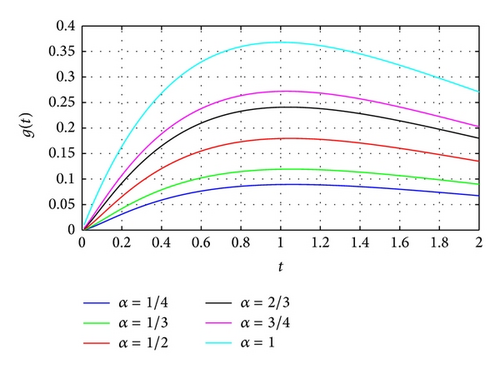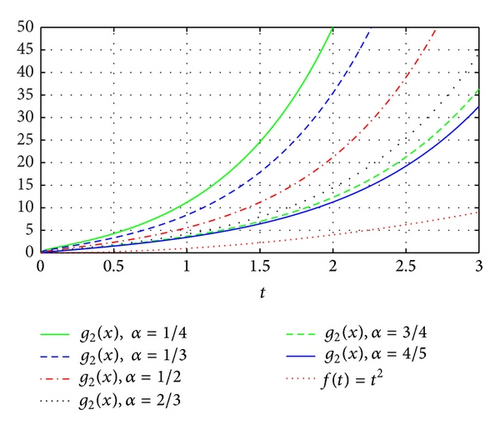The Oscillation of a Class of the Fractional-Order Delay Differential Equations
Abstract
Several oscillation results are proposed including necessary and sufficient conditions for the oscillation of fractional-order delay differential equations with constant coefficients, the sufficient or necessary and sufficient conditions for the oscillation of fractional-order delay differential equations by analysis method, and the sufficient or necessary and sufficient conditions for the oscillation of delay partial differential equation with three different boundary conditions. For this, α-exponential function which is a kind of functions that play the same role of the classical exponential functions of fractional-order derivatives is used.
1. Introduction
For the past three centuries, fractional calculus has been dealt with by mathematicians. In the recent decades, it is widely used in the fields of engineering, science, and economy. Recently, fractional differential systems have gained scholar’s attention [1–3]. Many researchers demonstrated applications of fractional calculus in the frequency dependent damping behavior of many viscoelastic materials, dynamics of interfaces between nanoparticles and substrates, the nonlinear oscillation of earthquakes, bioengineering, continuum and statistical mechanics, signal processing, filter design, circuit theory, and robotics. In some practical systems, such as economic systems, biological systems, and space-light industry systems, due to the transmission of the signal or the mechanical transmission, the research on fractional differential systems with delay is desired.
For the purpose, known methods are expanded for our results.
2. Preliminaries
We first give some definitions and make some preliminaries. The fractional-order derivative Dαx(t) can be defined in different ways, wherein Riemann-Liouville’s definition and Caputo’s definition are two main expressions as follows.
Definition 1. Riemann-Liouville’s fractional order derivative [3, 4] is defined by
Caputo’s fractional order derivative is defined by
Definition 2. α-exponential function is as follows [2]:
The derivative has the property of
Mittag-Lefflerfunction [3, 4] can be defined by
The first order delay differential equation including fractional-order derivative [2] is expressed by
Equation (10) is the characteristic polynomial of (8). The contribution in [2] is considered.
Lemma 3. The following statements are equivalent.
In this paper, the main results are derived from the application of the basic theory in [2]. The oscillation or nonoscillation of solutions for several fractional-order delay differential equations can be obtained based on these main results.
3. Main Result
3.1. The Fractional-Order Delay Differential Equation with Constant Coefficients
The detailed derivation can be found in Appendices A, B, and C. Using Lemma 3, we have the necessary and sufficient conditions for oscillation of all solutions of (11) as follows.
Corollary 4. The following statements are equivalent.
Proof. (1) If p < 0, it is obvious that (12) has a real root.
As p > 0, from the characteristic equation (12),
So p < 0 or , and (12) has a real root.
(2) In the same way, we get , and (12) has not a real root.
Theorem 6.
Proof. The equation has a solution , if and only if λ is a root of characteristic of equation . Using the conditions for (11), we have the following.
Example 7. We consider delay differential equation with fractional-order derivatives
All the conditions of Theorem 6 are satisfied. Fractional derivative of some special functions is as D1/2sint = sin(t + π/4). Thus, all the solutions of (15) are oscillatory. One of such solutions is x(t) = sint.
(H1): u > 0, f(u) ≥ Cu.
Theorem 8. Assume that (H) holds, and are satisfied. Every solution of the delay differential equation (17) oscillates.
Proof. We may assume that (17) has eventually positive solution. Then, there exists t0, and if t > t0, , x(t) > 0, and x(t − T) > 0.
We consider the eventually positive solution of the following inequality:
Assume the inequality (18) has a solution :
If , the inequality does not have a real root. That means every solution of the inequality (18) is oscillatory. Thus, if , every solution of the delay differential equation (17) oscillates.
3.2. The Fractional-Order Delay Differential Equation with Oscillating Coefficients
We have the sufficient conditions for oscillation of all solutions of (20) as follows.
Theorem 9. If t is sufficiently large, . Then, the solution of (20) is oscillatory.
Proof. Assume that (20) has eventually positive solution. If there exists t0 > 0 such that t > t0, then x(t) > 0, x(t − T) > 0,
Similar to the proof process of Theorem 8, every solution of the inequality (24) is oscillatory due to . Thus, the inequality (24) does not have eventually positive solution. Therefore, if t is sufficiently large, , and every solution of (20) is oscillatory. The proof of the theorem is complete.
Based on Lemma 3, the statements are equivalent for oscillation of all solutions of (25) and (26) as follows.
4. The Fractional-Order Delay Partial Differential Equation
-
(C1) a, bk ∈ C([0, ∞); [0, ∞)), and q is a nonnegative constant.
-
(C2) T, σk are nonnegative constants.
If there are no special instructions in this section, we only discuss the oscillation of solutions of the fractional-order delay partial differential equation with respect to time variable t.
Theorem 11. Assume that (C1) and (C2) hold, and (B1) is satisfied.
Proof. Let (x, t) ∈ Ω × [t1, ∞). Equation (29) on both sides of the integral of x in Ω is expressed by
By using Green’s formula and boundary conditions (B1),
Let . Substituting (30) with (31),
Based on Corollary 10, (1) and (2) in Theorem 14 are proved.
Example 12. Consider the parabolic equation:
Because of , all the conditions in Theorem 11 (1) are satisfied. By using Theorem 11, every solution of (33), with
-
(C3) pj, qj, Tj, σj are nonnegative constants.
Some sufficient conditions for oscillation of all solutions of (35) with (B2) and (B3) are established in Theorem 15. Before presenting the theorem, the lemma is given as follows.
Lemma 13. For the Dirichlet problem,
Theorem 14. Assume that (C1) and (C3) hold, and (B2) is satisfied. Every solution of the delay differential equation (26) with several coefficients oscillates. Then, every solution of (35) oscillates.
Proof. Let (x, t) ∈ Ω × [t1, ∞). If we multiply both sides of (35) by Φ(x) and integrate x in Ω, we obtain
By using Green’s formula and boundary condition (B2), we obtain
Based on Corollary 10, the proof of the theorem can be immediately completed. Let v(t) be defined as , t > t1, where u(x, t) denotes a solution of problem (35) with the boundary condition (B1) or (B3). Then, we obtain
Theorem 15. Assume that (C1) (C3) hold and (B1) is satisfied. Every solution of the delay differential equation with several coefficients (25) oscillates. Then, every solution of (35) with the boundary condition (B1) oscillates.
Proof. Let (x, t) ∈ Ω × [t1, ∞) on the x be the definite integral in Ω. Assume that (35) with the boundary condition (B1) has a nonoscillatory solution and (35) has an eventually positive solution:
By using Green’s formula and boundary condition (B1), we obtain
Let (t > t1) be substituted into (42). We obtain
The detail of the proof process is similar to the proof process of Theorem 15.
Theorem 16. Assume that (C1) and (C2) hold and (B3) is satisfied. Every solution of the delay differential equation with the coefficients (25) oscillates. Then, every solution of (35) with the boundary condition (B3) oscillates.
Proof. Let (x, t) ∈ Ω × [t1, ∞) on the x be the definite integral in Ω. For the sake of contradiction, assume that (35) with the boundary condition (B3) has a nonoscillatory solution and (35) with the boundary condition (B1) has an eventually positive solution:
By using Green’s formula and boundary condition (B3), we obtain
The detail of the proof process is similar to the proof process of Theorem 15.
-
(C4) Tk, σi are nonnegative constants.
-
(C5) a(t), bk(t), qi(t) ∈ C([0, ∞); [0, ∞)), k = 1, 2, …, m; i = 1, 2, …, n; where qi = infqi(t) is a nonnegative constant.
-
(H2) fi(u) ∈ C(R, R), and u > 0, fi(u) ≥ ci u, i = 1, 2, …, n.
Theorem 17. Assume that (C4), (C5), and (H2) hold and (B1) is satisfied. If , the solution of (48) with the boundary condition (B1) is oscillatory.
Proof. Let (x, t) ∈ Ω × [t1, ∞). Assume that (48) with the boundary condition (B2) has no oscillation solutions, and (48) has eventually positive solution. If there exists t2 > t1 such that t > t2, then u(x, t) > 0, u(x, t − Tk) > 0, u(x, t − σj) > 0. If (H2) is satisfied, (48) can be transformed into the inequality as follows:
The inequality (49) on both sides of the integral of x in Ω is expressed by
By using Green’s formula and boundary conditions (B1), we obtain
Substituting (50) with (51) and , we obtain
By using Theorem 9, the proof of the theorem can be completed.
Conflict of Interests
The authors declare that there is no conflict of interests regarding the publication of this paper.
Acknowledgment
The authors thank Mr. Weisheng Xu for useful discussions on the proof process in the paper.
Appendices
A. Maximum of
Figure 1 illustrates the curves of the function with different α. From bottom to top, α = 1/4, 1/3, 1/2, 2/3, 3/4, and 1, respectively. From Figure 1, it can be observed that there exists M such that (ω ≥ 1). In detail, the values of g(t) with different α are reported in Table 1. m is the maximum for a fixed α in Table 1.
| α = 1/4 | α = 1/3 | α = 1/2 | α = 2/3 | α = 3/4 | α = 1 | |
|---|---|---|---|---|---|---|
| t = 0.9 | 0.0881072 | 0.1176864 | 0.1774485 | 0.2383790 | 0.2694375 | 0.3659126 |
| t = 0.95 | 0.0887969 | 0.1185872 | 0.1787170 | 0.2399068 | 0.2710383 | 0.3674039 |
| t = 1 | 0.089205 | 0.1191138 | 0.1794311 | 0.2407091 | 0.2718332 | 0.3678794 (m) |
| t = 1.01 | 0.0892548 | 0.1191774 | 0.1795119 | 0.2407885 | 0.2719021 | 0.3678611 |
| t = 1.02 | 0.0892949 | 0.1192275 | 0.1795730 | 0.240842 | 0.2719425 | 0.3678068 |
| t = 1.03 | 0.0893251 | 0.1192646 | 0.1796147 | 0.2408705 | 0.2719547 (m) | 0.3677171 |
| t = 1.04 | 0.0893456 | 0.1192889 | 0.1796375 | 0.2408740 (m) | 0.2719395 | 0.3675928 |
| t = 1.05 | 0.0893567 | 0.1193007 (m) | 0.1796417 (m) | 0.2408533 | 0.2718973 | 0.3674346 |
| t = 1.06 | 0.0893585 (m) | 0.1193001 | 0.1796277 | 0.2408087 | 0.2718286 | 0.3672431 |
| t = 1.07 | 0.0893512 | 0.1192875 | 0.1795959 | 0.2407409 | 0.2717341 | 0.3670191 |
| t = 1.08 | 0.0893351 | 0.1192631 | 0.1795465 | 0.2406501 | 0.2716142 | 0.3667631 |
| t = 1.09 | 0.0893102 | 0.1192271 | 0.1794801 | 0.2405370 | 0.2714694 | 0.3664759 |
| t = 1.1 | 0.0892768 | 0.1191797 | 0.1793968 | 0.2404020 | 0.2713003 | 0.3661581 |
| t = 1.15 | 0.0889875 | 0.1187809 | 0.17874 | 0.2394135 | 0.2701071 | 0.364132285 |
| t = 1.2 | 0.0885098 | 0.1181318 | 0.1777141 | 0.2379416 | 0.2683777 | 0.361433054 |

B. Supplementary Comment of g(t)
The curves of function and g3(t) = t2 (t > 0) are showed in Figure 2. The function g2(t) is a supplementary comment of the maximum value of g(t). From top to bottom, α = 1/4, 1/3, 1/2, 2/3, 3/4, and 4/5, respectively.

C. The Characteristic Equation
In the most general form F(s)X(s) = Q(s), we can obtain and Q(s) = x(0) − ph(sT). F(s) and Q(s) are both entire functions. Assume F(s) ≠ 0 for all real s. X(s) can be expressed as X(s) = Q(s)/F(s), Res > s0 > 0. Therefore, is the characteristic polynomial of (11).




